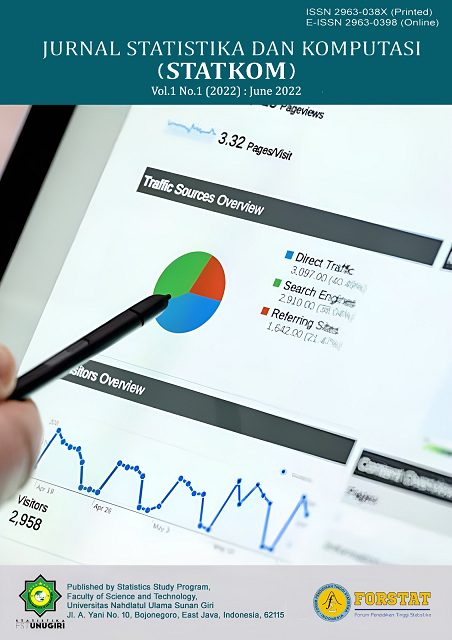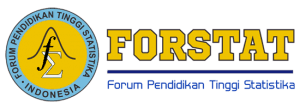Peramalan Banyaknya Pasien Rawat Jalan dengan Menggunakan Metode Brown's Double Exponential Smoothing
 PDF Download: 950
PDF Download: 950
DOI:
https://doi.org/10.32665/statkom.v1i1.451Keywords:
Peramalan , Deret Waktu , Brown's Double Exponential Smoothing , Pasien Rawat JalanAbstract
Latar Belakang: Peramalan memainkan peran penting dalam kegiatan pengambilan keputusan dalam manajemen organisasi. Kebutuhan akan peramalan yang andal semakin meningkat seiring upaya manajemen untuk mengurangi ketergantungannya pada peluang dan menjadi lebih ilmiah dalam menangani masalah-masalahnya. Terutama masalah yang terjadi pada kasus peramalan banyaknya pasien rawat jalan di Dr. R. Sosodoro Djatikoesoemo Bojonegoro. Peningkatan banyaknya pasien rawat jalan dapat diperkirakan sehingga menjadi antisipasi manajer rumah sakit dalam persediaan obat-obatan, fasilitas kesehatan, dan tenaga kesehatan.
Tujuan: Meramalkan banyaknya kunjungan pasien rawat jalan di RSUD Dr. R. Sosodoro Djatikoesoemo Bojonegoro dengan model Brown's double exponential smoothing.
Metode: Digunakan metode kuantitatif berupa peramalan deret waktu dengan menggunakan model Brown's double exponential smoothing dengan satu parameter yaitu ?. Model peramalan diperoleh melalui pemilihan ? terbaik berdasarkan kriteria model terbaik yaitu mean absolute percentage error (MAPE).
Hasil: Diperoleh model terbaik dengan ? sebesar 0,2 dan MAPE sebesar 18. Hasil peramalan model untuk 5 bulan ke depan adalah 12.643 pada bulan Agustus, 12.895 bulan September, 13.147 bulan Oktober, 13.399 bulan November, dan 13.651 bulan Desember.
Kesimpulan: Hasil peramalan pasien rawat jalan di RSUD Dr. R. Sosodoro Djatikoesoemo untuk 5 bulan menjadi masukan pengetahuan dugaan ke depan bagi manajemen rumah sakit dalam mengatasi banyaknya pasien rawat jalan.
References
Ahmad, F. (2020). Penentuan Metode Peramalan Pada Produksi Part New Granada Bowl ST Di PT. X. Jurnal Integrasi Sistem Industri, 7(1), 31–39.
Arridho, M. N., & Astuti, Y. (2020). Penerapan Metode Single Exponential Smoothing untuk Memprediksi Penjualan Katering pada Kedai Pojok Kedaung. Jurnal Ilmiah Intech : Information Technology Journal of UMUS, 2(02), 35–44. https://doi.org/10.46772/intech.v2i02.288
Bojonegorokab. (2022). Data Penyakit dan Kunjungan Rawat Jalan. https://data.bojonegorokab.go.id/rsud-sosodoro-djatikoesoemo.html@detail=rawat-jalan
Chukwulozie, O. P., Chukwuneke, J., Chinagorom, E., & Christopher, C. T. (2017). The Analysis of Cigarate ProductionUsing Double Exponential Smoothing Model. Academic Journal of Science., 7(2), 293–308.
Hayuningtyas, R. Y. (2020). Implementasi Metode Triple Exponential Smoothing Untuk Prediksi Penjualan Alat Kesehatan. EVOLUSI : Jurnal Sains Dan Manajemen, 8(1), 29–35. https://doi.org/10.31294/evolusi.v8i1.7404
Krakataumedika. (2020). Kewajiban Rumah Sakit kepada Pasien dan Masyarakat. https://krakataumedika.com/info-media/artikel/kewajiban-rumah-sakit-kepada-pasien-dan-masyarakat
Lawalata, F., Sediyono, E., & Purnomo, H. (2021). Analisis Prediksi Jumlah Pasien Rawat Inap di Rumah Sakit GMIM Siloam Sonder Menggunakan Metode Triple Exponential Smoothing. Jointer - Journal of Informatics Engineering, 2(01), 32–26. https://doi.org/10.53682/jointer.v2i01.28
Muchayan, A. (2019). Comparison of Holt and Brown’s Double Exponential Smoothing Methods in The Forecast of Moving Price for Mutual Funds. Journal of Applied Science, Engineering, Technology, and Education, 1(2), 183–192. https://doi.org/10.35877/454ri.asci1167
Munarsih, E. (2017). Peramalan Jumlah Pengangguran di Provinsi Sumatera Selatan dengan Metode Autoregressive Integreted Moving Average (ARIMA). Jurnal Penelitian Sains, 19(1), 1–5.
Nurdiansyah, D., & Wafa, K. (2021). Penerapan Model Exponential Smoothing berbasis Metode Evolutionary pada Kasus COVID-19 dan DBD di Bojonegoro. Jurnal Kesehatan Vokasional, 6(3), 174–181. https://doi.org/10.22146/jkesvo.65937
Pujiati, E., Yuniarti, D., & Goejantoro, R. (2016). Peramalan Dengan Menggunakan Metode Double Exponential Smoothing Dari Brown (Studi Kasus : Indeks Harga Konsumen (IHK) Kota Samarinda). Jurnal EKSPONENSIAL, 7(1), 33–40. http://jurnal.fmipa.unmul.ac.id/index.php/exponensial/article/view/23
Rachmat, & Suhartono. (2020). Comparative Analysis of Single Exponential Smoothing and Holt’s Method for Quality of Hospital Services Forecasting in General Hospital. Bulletin of Computer Science and Electrical Engineering, 1(2), 80–86. https://doi.org/10.25008/bcsee.v1i2.8
Rsupermatahati. (2020). Rawat Jalan. https://rsupermatahati.com/id/Rawat-Jalan-View
Silitonga, P. D. P., Himawan, H., & Damanik, R. (2020). Forecasting Acceptance Of New Students Using Double Exponential Smoothing Method. Journal of Critical Reviews, 7(1), 300–305. https://doi.org/10.31838/jcr.07.01.57
Sudibyo, N. A., Iswardani, A., Septyanto, A. W., & Wicaksono, T. G. (2020). Prediksi Inflasi Di Indonesia Menggunakan Metode Moving Average, Single Exponential Smoothing Dan Double Exponential Smoothing. Lebesgue : Jurnal Ilmiah Pendidikan Matematika, Matematika Dan Statistika, 1(2), 123–129. https://doi.org/10.46306/lb.v1i2.25
Downloads
Published
How to Cite
Issue
Section
License
Copyright (c) 2022 Nuraini Khoiriyah, Nita Cahyani

This work is licensed under a Creative Commons Attribution-ShareAlike 4.0 International License.
Authors who publish with this journal agree to the following terms:
- Authors retain copyright and grant the journal right of first publication with the work simultaneously licensed under a Creative Commons Attribution License - Share Alike that allows others to share the work with an acknowledgment of the work's authorship and initial publication in this journal.
- Authors are able to enter into separate, additional contractual arrangements for the non-exclusive distribution of the journal's published version of the work (e.g., post it to an institutional repository or publish it in a book), with an acknowledgment of its initial publication in this journal.
- Authors are permitted and encouraged to post their work online (e.g., in institutional repositories or on their website) prior to and during the submission process, as it can lead to productive exchanges, as well as earlier and greater citation of published work.
USER RIGHTS
All articles published Open Access will be immediately and permanently free for everyone to read and download. We are continuously working with our author communities to select the best choice of license options, currently being defined for this journal as follows:
 PDF Download: 950
PDF Download: 950














